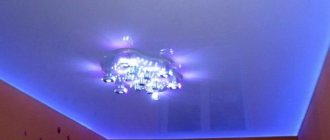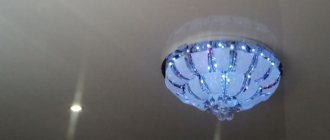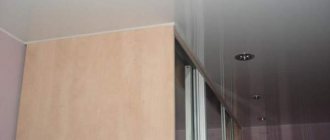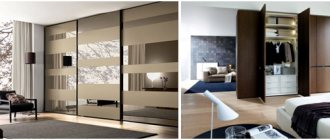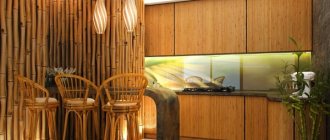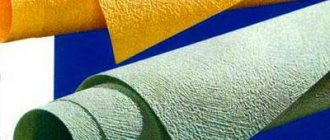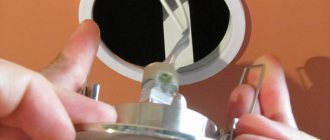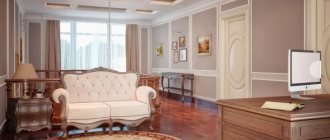Each of us wants to create an unusual interior in our home, pleasing to the eye and arousing the admiration of others. Today there are many means for these purposes - original finishing materials, decorative elements, etc. One of the options for the original design of a home is molding. What it is? These are overlay panels (plinths) of various shapes, used to decorate walls, ceilings, and furniture. This element allows you to add original features to any room. In this article we will tell you how to use moldings to finish the ceiling.
Types of decorative panels
Nowadays, you can choose decorative skirting boards in a variety of configurations and sizes. They can be smooth and patterned, with relief patterns or imitation stucco. This type of finishing is also produced in different materials, it can be:
- wood;
- plaster;
- foam;
- polyurethane.
The last type is the most widespread. Polyurethane, compared to other materials, has many advantages:
- moisture resistant (can be used in the bathroom, swimming pool, etc.);
- tolerates both low and high temperatures;
- retains its original color for many years;
- not deformed.
Polyurethane panels are the best choice for sealing joints between the wall and the ceiling.
Molding. What is this?
Molding is an applied decorative element. In common parlance it is usually called a ceiling plinth, which is essentially the same thing. Moldings differ in the material they are made of, the design of the ceiling and their location. There are also non-standard purposes for using ceiling plinths.
Types of molding have specific names depending on their location:
- The plinth is located at the joints between the wall and the floor.
- Fillet or baguette - between the walls.
- A fillet or ceiling plinth is used to finish the corner between the wall and the ceiling.
- Platbands are used to frame window and door openings.
- Frames – for framing mirrors and paintings.
- Tiles are used to decorate stoves and fireplaces.
- If the moldings cross the walls, then these are pilasters, and if they cross the ceiling, then these are ceiling borders.
- There are moldings that cover large areas of walls or ceilings. Then these elements are called panels and “medallions”.
Moldings are used for a variety of purposes. They can mask some defects, irregularities or cracks. You can visually correct the geometry of the room or use this element to zone rooms. These are purely practical goals, but there are conceptual ones, when with the help of moldings you can create a certain style of the room. For example, if embossed ornate details are painted to look like stucco with gilding, you will get the style of the Renaissance, antiquity, and the Middle Ages. Any modest apartment in a modern high-rise building can be turned into a royal mansion if such spectacular design details are correctly applied.
More formal moldings painted in metallic will fit perfectly into the high-tech style, and frames around windows and doors will add rustic chic to the room in Provence or country style. Frames, borders, medallions and other things can be used to emphasize or highlight individual interior elements - portraits, landscapes, chandeliers, decorative candlesticks. With pilasters you can divide the wall and highlight panels, which are painted in a color contrasting with the rest of the walls, covered with wallpaper or laid with tiles, as we see in the photo below.
Advantages of using molding
The main advantage of installing moldings on the ceiling is the ability to add originality to any interior. But this is far from the only advantage of this decorative element. For example, ceiling molding will help hide surface unevenness. Also, with the right color of this element, you can visually expand the room. This effect can be achieved if the baseboard is the same color as the finishing of the walls and ceiling. Another important plus is affordability. Ceiling moldings made of polystyrene foam and polyurethane are available to absolutely everyone. Wooden and plaster models are much more expensive, but also not exorbitantly expensive.
Modern interior
In such an interior, discreet, smooth skirting boards look best. They can be used to zone a space in a very interesting way - laying out all sorts of geometric shapes on the ceiling. It is very popular from the center of the ceiling, where the chandelier is located, to place several rectangles or circles of decorative panels, increasing in size. In terms of color, you can use any shades - to match the tone of the room’s decoration or, on the contrary, play in contrast. The last option is suitable only for rooms with high ceilings.
Constructivism implies restraint. In such an interior there is almost no decor in the form of additional small elements. Therefore, the decor in this case should be smooth, without any relief ornaments or stucco molding. For example, you can zone the space into equal squares using thin, smooth skirting boards. In this case, the chandelier in the center does not look good; it is much more effective to place spots in the center of each square.
Bright, contrasting figures will look great in pop art
complement the high-tech with decor in shades of gray, metallic, and chrome.
In short, any style can be emphasized favorably with a properly selected decorative element. A flat, smooth ceiling without any decoration looks boring, so it’s worth diversifying the interior of your home. Fortunately, the variety of decorative elements today can satisfy people with very different tastes.
Take note: the more spacious the room and the higher the room, the larger the baseboard can be and the more elaborate the relief pattern on them.
Features of stickers for decorative skirting boards
There are different options for finishing the ceiling with molding. The installation method directly depends on the material with which the ceiling surface is lined. First, let's look at options for gluing decor to a regular and plasterboard ceiling.
Start gluing this decor from the corner.
Polyurethane materials are usually glued using liquid nails or special assembly adhesive. The work includes several stages:
- removing debris and dust from work surfaces;
- treating the future locations of elements with a primer;
- applying glue and installing the panel;
- removing any glue that has come out;
- sealing the resulting gaps with sealant.
How to glue plinths on suspended ceilings
For ceilings with stretch fabric, you can only use foam or polyurethane plinths, due to the light weight of these materials. Installation begins in the same way - with surface preparation. Only in this case, only the wall to which it will be glued is treated with a primer.
The plinth cannot be glued to the tension fabric, as it may become deformed.
Now let's move on to preparing the panel itself. Since in this case the surface will not be painted, if you want to paint the baseboard, this must be done before installation. When the paint is completely dry, it is glued to the wall. After the glue has dried, carefully seal the seams.
How and with what to glue plinths and other elements to a suspended ceiling
Clients of the Mos Siling company have questions regarding the process of installing suspended ceilings, their maintenance and repair, among which the following is popular: how to glue skirting boards onto a suspended ceiling?
Stretch ceiling and plinth
You will probably be surprised, but it is impossible to answer how to glue the ceiling plinth to the stretch ceiling. The answer is nothing. It is impossible to glue anything of any significant weight to a thin vinyl sheet. Why?
There are several good reasons for this:
- if you try to glue the baseboard to the vinyl sheet, the glue will cause it to sag, may become wrinkled and even dissolve;
- the film is not firmly fixed in the frame, so the plinth would come off due to air movement;
- with the harpoon installation method, the canvas is dismantled to drain water in case of flooding and dry the ceiling or to replace wiring, heating pipes, etc. Naturally, a glued baseboard would interfere with this process.
According to the technology, the hole between the ceiling and walls is closed with a special masking tape, white or painted to match the shade of the ceiling/walls. Questions about how and with what to glue the baguettes arise if the stretch ceiling is decorated in a historical style and an imitation of stucco molding is required.
In this case, the solution is very simple: the skirting boards are glued not to the tension film, but to the walls. Moreover, you can choose any material and type of finishing: polystyrene foam, natural wood and polystyrene foam.
How to glue foam baseboard
The Mos Siling company's craftsmen install suspended ceilings and masking tapes, but you can install ceiling skirting boards yourself. They can be glued directly to painted or wallpapered walls.
Another reason for using skirting boards is uneven walls. Therefore, when gluing the plinth, you should not use a level, just measure the same distance from the tension fabric.
For fastening, you can use any acrylic glue, which is applied only to the lower part of the plinth (when choosing a decor, pay attention not only to its appearance, but also to the width of the vertical part, due to which it will be glued).
To aesthetically join any type of ceiling plinths, you will need a miter box. With its help, a sharp construction knife can easily cut the foam. Don't worry about small irregularities - they are hidden thanks to acrylic putty.
Features of gluing polystyrene foam
The difference between polystyrene foam is that it is thinner, but much denser and heavier than polystyrene foam, so gluing it is much more difficult. That is why in this case the baguettes are attached directly to the wall, and not wallpaper.
The walls are first coated with a primer on top to strengthen the plaster. To ensure reliable gluing of the baseboard, you can use adhesive putty in residential areas and liquid neopropylene nails in bathrooms and other wet rooms.
Fastening a wooden baseboard
Wooden moldings with suspended ceilings are rarely used. They can be fixed with glue-putty or screwed with self-tapping screws to the walls every half meter. The heads of the screws are puttied and painted the same color as the baseboard.
How to glue a suspended ceiling
Mos Siling specialists are also interested in how and with what vinyl films are glued. When installing suspended ceilings, adhesives are not used. Glue and vinyl are connected only in three cases:
- when installing lighting devices;
- when gas pipes, heating pipes, hoods and other elements enter the ceiling;
- for repairing cuts and punctures.
Lamps. As you already understand, nothing can or cannot be hung on a suspended ceiling. Spotlights and chandeliers are attached to the base ceiling. To do this, before installing the canvas, embedded parts are installed - racks or platforms.
After stretching the film, you need to make holes in it to install the lamps. However, any holes in the vinyl from tension will stretch and tear further, so all technical holes are reinforced with special plastic rings.
This is where glue comes in handy. Typically, Mos Siling specialists use CosmofenCA12. Cosmofen is a one-component product based on cyanoacrylate, characterized by instant hardening.
Opposite the embedded part, an armored ring is glued to the canvas, and then a film is cut along its inner diameter and the lamp is fixed and connected through the resulting hole.
Pipes and hoods. When installing suspended ceilings in many rooms, pipe bypass is required. The principle here is similar, only reinforcement parts often need to be made manually by Mos Siling company craftsmen from special thin plastic and glued to the film with Cosmofen from the outside or from the inside, depending on the situation.
Repair. If you accidentally get cuts or punctures in the canvas, this is the moment when you need to decide how and with what to glue the stretch ceiling in order to repair it. By the way, gluing is far from the only way to repair.
The easiest repair method is a patch. Although at first glance it seems that you can handle this work yourself, Mos Siling specialists do not recommend experimenting, but trusting professionals.
Firstly, instantly hardening glue requires a lot of skill and experience working with it. Secondly, it contains a toxic substance. Thirdly, the task is not just to glue a patch, but to return the ceiling to its ideal appearance, and you need to be able to do this.
Mos Siling specialists can decorate the hole by applying an inconspicuous patch or insert a new lamp, glue a false exhaust grille, mount a mirror or a polyurethane rosette around the chandelier.
Conclusion
Now you know how and with what to glue a suspended ceiling when repairing it, you have received information about the intricacies of installing lamps and installing ceiling plinths, but theoretical knowledge does not replace experience and practice. Therefore, it is better to entrust all this work to the professionals of the Mos Siling company.
We recommend reading:
Manufacturing of suspended ceilings
2-level stretch ceiling
Unique features of fabrics
Multifunctionality of stretch ceilings: how can you use a unique material?
Reviews about stretch ceilings Pongs
Useful tips
- Carefully select the adhesive for the material. Some adhesives contain quite aggressive substances that can damage the decor being glued.
- To help the panel stick better, you can use masking tape. Once the glue has completely dried, the tape can be easily removed.
- You can also use self-tapping screws to press the panel more tightly to the surface. After drying, they can be removed or simply painted over to match.
- When choosing the type of decor, first of all, focus on its compliance with the style of your home.
- Before purchasing, it is good to first look at the types of decorative panels on the Internet. This will help you quickly understand what will suit your interior best.
How to remove adhesive residue from a tension covering?
Polyvinyl chloride film is a material characterized by a fragile structure. When caring for such a coating, do not use mops or brushes with hard bristles. The canvas is very stretched, so it may not withstand pressure. Remaining adhesive should be removed very carefully. A soft sponge and glue cleaner, which is sold at any hardware store, are suitable for the job.
Please note that adhesive for tension coverings is more difficult to remove from the surface, so more effort will be required.
Removing super glue from a stretch ceiling

